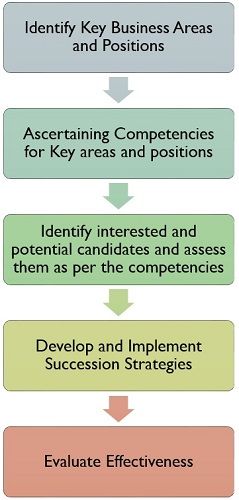Definition: Succession Planning is defined as the systematic process of recognizing and creating future leaders who are able to take the position of the old ones when they leave the organization due to retirement, resignation, termination, transfer, promotion or death.
In finer terms, it is a modern technique followed by many companies, that concentrates on identifying the prospects, out of many employees in the organisation, who might be possible successors, for the key positions.
Need for Succession Planning
Succession Planning is a part and parcel of the Human Resource Planning, which acknowledges that the employees may or may not work with the organization in the future. And so to be at the safer side, a succession plan is developed to analyse the vacancies which might take place when an employee leaves the organization, the business areas which might be affected, job requirements and the skills of the existing incumbent.
Hence, there is a need for strategic planning, to determine where and how viable employees can fill the vacant positions.
Process of Succession Planning
- Identifying Key Business Areas and Positions: First and foremost, the key business areas are identified, i.e. the areas which are significant with respect to the operational activities and strategic objectives. After that, those positions are identified which if vacant can cause difficulty in achieving business objectives.
- Ascertaining Competencies for Key areas and positions: Next, you need to determine the required competencies for key business areas and position, in order to create the selection criteria, establish performance standards and fill the difference between what the viable successors know and what they need to know, through the training and development process.It determines the knowledge, skills, ability and experience required to achieve business goals.
- Find out the interested and potential candidates and assess them as per the competencies: After competency is analysed, the next step is to identify among various employees working in the organization, who are interested as well as they have the capability to fill key business areas and positions.The Human Resource Manager discusses future career plans and interests with the candidates and identifies the potential successors who are ready to replace the old ones and can be trained and developed for future contingencies.
- Develop and Implement Succession Strategies: Strategies for learning, training, development, knowledge transfer, experience sharing is developed and implemented for potential successors.
- Evaluate Effectiveness: The last step to the succession planning process is to evaluate the succession planning and management, to ensure that all the key business areas and positions are covered under the succession planning.Further, it also ensures that in case of any sudden vacancies in future, key positions can be filled as soon as possible and the successors perform effectively when they hold the position.
Therefore, Succession Planning is all about developing a leadership substitute, for a perpetual succession of the organization without any kind of disturbance, when there are changes in the top management.
An ideal Succession Planning is one that involves the participation of the top management, a thorough review of the plan developed, evaluation of the performance and capability of the candidates and each candidate is provided with the written development plan.
It is a rational decision of the management to promote the regular development of the workforce, to make sure that the top managerial positions have some sort of stability, thus ensuring an organization to attain its ultimate objectives.


Sudhakar Sharma says
Good detail is given
Very easy language
Very clear & Pratical words
Thanks for sharing
Duong Kim Chau says
It is simple and clear to understand. Thank you so much 😊
pepijanuarpelita says
thanks so much, very simply, thanks for share
Trishala Nagpure says
Crisp and clear explanation.